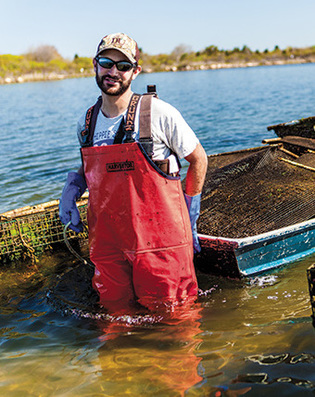 loading
loading
featuresJules Opton-Himmel: the accidental oystermanOysters. Kelp. And an oyster-and-chocolate-flavored stout.  Jason Houston“In the beginning, we killed a lot of oysters,” confesses Jules Opton-Himmel ’07MEM. But even oyster farming gets easier with practice. View full imageFarming has always been a tough business. As Jules Opton-Himmel ’07MEM maneuvers his work skiff deftly around his oyster farm, he acknowledges that there are easier ways to make a living. “There was a pretty steep learning curve,” he says. “And in the beginning, we killed a lot of oysters. That still happens. But every year, we get better.” We’re in the productive waters of Dutch Harbor, off Jamestown, Rhode Island, on a two-acre floating farm that is just one section of Opton-Himmel’s growing mariculture operation. Black floats on the surface buoy up special open-mesh plastic bags, in which hundreds of thousands of delectable oysters are growing. The trim-bearded and -bodied 37-year-old, clad in chest-high waders, looks the waterman’s part. (Actually, he grew up in lower Manhattan.) As an undergrad at Wesleyan, he got hooked on environmental science and, after graduation, worked as a field ecologist in Missouri, Washington, and Massachusetts. Realizing he needed an advanced degree to pursue an environmental management career, Opton-Himmel came to Yale’s forestry and environment school to study land use and energy. “At Yale, I also decided that I wanted to have an oyster farm,” he says. “I had gone clamming for fun, and I discovered that you could lease land underwater in Long Island Sound for as little as two dollars an acre.” Opton-Himmel took the plunge in 2009, launching the Walrus and Carpenter Oyster Farm on 1,000 square feet of a Rhode Island salt pond called Ninigret. “I started with about 10 cages and 60,000 oysters, a 14-foot aluminum boat named Muddy Waters, and a two-door Honda Civic for transport,” he says. “I was living in a tent near the farm.” The original lease has grown to about six acres on Ninigret—eight including the Jamestown farm—and the company and its staff of eight now plant and nurture about three million oysters a year. Oysters take on the flavor of where they’re grown. Connoisseurs call it the merroir, a play on the wine world’s terroir. Opton-Himmel describes his Ninigret harvest as “brine and buttery” and the Jamestown oysters as “packing a salt punch with a clean finish.” They’re sought by more than 50 restaurants, especially in Providence’s burgeoning food scene. Opton-Himmel is expanding in several directions. He has begun to raise kelp to tap into a multibillion-dollar worldwide market for seaweed (his crop is destined to become sea salads), and he has collaborated with a local brewery to develop custom-crafted beers: Shuckolate, a stout that marries the flavors of oysters and chocolate, and Forecast Chapter 2, a gose-style sour brew based on kelp. And in the summer, the business hosts a unique kind of agritourism: a tour of the Ninigret farm, followed by a sit-down meal on a sandbar with fine wine, a menu developed by some of the area’s best chefs, and, of course, Walrus and Carpenter oysters. “I’m interested in businesses that are good for the environment and profitable,” says Opton-Himmel. “Here, we’ve shown we can be both.”
The comment period has expired.
|
|